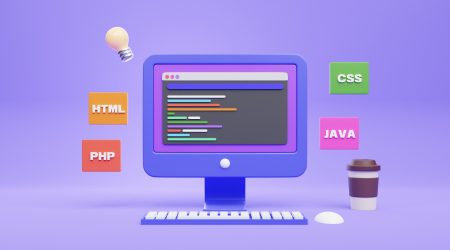The 7 Hardest Programming Languages to Learn in 2024
Programming is the backbone of our digital age. From web development to artificial intelligence, the world runs on code. While many programming languages make it easier for developers to bring their ideas to life, some exist to challenge even the most seasoned coders. If you’re ready to test your limits—or just curious about the craziest code out there—this post is for you. Let’s explore the seven hardest programming languages to learn in 2024 and why they pose a formidable challenge.
What Are the Hardest Coding Languages?
The realm of coding is vast, with each language designed to tackle specific problems. Some are created to be user-friendly, while others push the boundaries of complexity. This blog post dives deep into seven of the hardest programming languages to learn, examining what makes them difficult and who might benefit from mastering them.
Whitespace
The Invisible Language
Whitespace is an esoteric programming language in which only spaces, tabs, and line breaks have meaning. It’s like writing a novel in which words are invisible, and punctuation drives the plot.
Why It’s Hard
Whitespace’s primary challenge lies in its invisibility. Debugging becomes a nightmare when errors are invisible to the naked eye. Understanding code in Whitespace requires exceptional attention to detail and a penchant for the abstract.
Use Cases
While not practical for everyday programming, Whitespace is an excellent exercise for sharpening logical thinking skills. It’s used mainly for academic purposes and mental gymnastics.
Malbolge
The Diabolical Code
Malbolge is named after the eighth circle of hell in Dante’s Inferno, Malbolge is intentionally complex. It was designed to be almost impossible to program.
Why It’s Hard
Malbolge’s syntax and operations are convoluted and counterintuitive. It uses an encryption-like mechanism to obscure code, making it extraordinarily hard to understand and write. Even the simplest “Hello, World!” program can seem impossible.
Use Cases
Malbolge has no practical applications. It is a challenge to programmers, a sort of “Mt. Everest” of coding.
Brainf**k
The Minimalist Maze
Brainfuck, despite its crude name, is known for its minimalist design. With only eight commands, it’s designed to test the boundaries of how little one needs to write a program.
Why It’s Hard
The language’s minimalism is both its strength and its curse. With no built-in commands for everyday tasks, everything must be done manually, requiring complex sequences of commands for even the simplest operations.
Use Cases
Brainfuck serves an educational purpose, helping coders understand how computer memory works. It’s also a favorite for coding challenges and competitions.
Haskell
The Functional Fortress
Haskell is a standardized, general-purpose, purely functional programming language. Haskell is powerful and perplexing, known for its advanced type system and mathematical roots.
Why It’s Hard
Haskell’s learning curve is steep due to its abstract concepts, monads, and non-strict evaluation. Understanding and applying these concepts requires a deep understanding of functional programming principles.
Use Cases
Haskell is used in academia and industry for applications requiring high reliability and complex algorithms. Its rigorous type system makes it ideal for financial modeling and concurrent computing.
Intercal
The Satirical Syntax
Intercal, short for “Compiler Language With No Pronounceable Acronym,” was created as a parody of programming languages. It deliberately avoids conventional programming constructs to be as confusing as possible.
Why It’s Hard
Intercal’s syntax is bizarre and counterintuitive. Commands like `PLEASE DO` and `FORGET` are designed to be obfuscated and illogical, making writing and debugging code extremely difficult.
Use Cases
Intercal isn’t used for any real-world applications. It’s a curiosity intended to make a statement about the complexity of programming languages.
C++
The Versatile Veteran
C++ is a powerful, high-performance language widely used in system/software development, game development, drivers, client-server applications, and embedded firmware.
Why It’s Hard
C++ combines the complexity of low-level programming with the intricacies of object-oriented design. It has a vast standard library, intricate syntax, and manual memory management, which can be daunting for beginners.
Use Cases
C++ is used in various high-performance applications, including game development, real-time systems, and large-scale software engineering projects.
Rust
The Safety-Centric System Language
Rust is a systems programming language that majorly focuses on safety, speed, and concurrency. It’s designed to prevent many types of errors that plague other languages.
Why It’s Hard
Rust’s steep learning curve comes from its strict compiler and ownership system, which ensures memory safety without a garbage collector. Learning to work within these constraints can be challenging.
Use Cases
Rust is ideal for system-level programming, web assembly, and situations where performance and safety are paramount, such as in embedded systems and high-concurrency environments.
Conclusion
Understanding the hardest programming languages to learn in 2024 gives us a glimpse into the diverse challenges and mind-stretching puzzles coding can offer. Whether it’s deciphering the invisible code of Whitespace, battling the diabolical complexity of Malbolge, or mastering the rigorous constraints of Rust, each language pushes the boundaries of what’s possible in programming.
The rewards are immense for those brave enough to tackle these tough languages. Not only do you sharpen your problem-solving skills and deepen your understanding of computer science, but you also join an exclusive club of coders who have faced and conquered these formidable challenges.
If you’re ready to take your coding skills to the next level, start small and work your way up. And remember, programming is as much about persistence and creativity as it is about logic and syntax. Happy coding!
If you’re eager to explore more about these languages or start your own coding adventure, visit [Learning Resource] and sign up for personalized guidance.













Comments (3)
Attractive section of content. I simply stumbled upon your website and in accession capital
to claim that I geet in fact loved account your bpog posts.
Anyy way I’ll be subscribing on your feeds and even I achiegement you get right oof entry to consistently rapidly.
This blog provides an insightful examination of the most challenging programming languages, assisting developers in making informed choices for their learning journey! I appreciate this breakdown; it’s essential to grasp the difficulties before embarking on a new language.
Hey! Do you use Twitter? I’d like to follow you if that would be
okay. I’m undoubtedly enjoying your blog and look
forward to new posts.